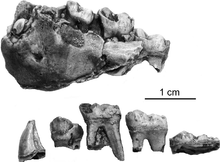Anapithecus
| Anapithecus Temporal range: Late Miocene | |
|---|---|
 | |
| Scientific classification | |
| Kingdom: | Animalia |
| Phylum: | Chordata |
| Class: | Mammalia |
| Order: | Primates |
| Suborder: | Haplorhini |
| Family: | Pliopithecidae |
| Subfamily: | Crouzeliinae |
| Tribe: | Anapithecini |
| Genus: | Anapithecus† Kretzoi, 1975 |
| Species | |
Anapithecus (pronounced Ana-PITH-i-kuhs; from Greek πίθηκος pithekos "ape") is a late Miocene primate (10 million years old) known from fossil locations in Hungary and Austria.[1] Many Anapithecus fossils come from the site of Rudabánya, in northern Hungary, where Anapithecus lived alongside the ape Rudapithecus'.[2][3] Anapithecus hernyaki is named after Mr. Gabor Hernyák, chief geologist of the Iron Ore Works of Rudabánya.[4]
Classification and Phylogeny
Anapithecus belongs to the clade Pliopithecoidea, an extinct group of primates that inhabited Eurasia during the Miocene epoch (17-7 million years ago).[5] Pliopithecoids are catarrhine primates, sharing a common ancestor, and many physical characteristics, with both apes and old world monkeys. Evolutionarily speaking pliopithecoids are considered to be a primitive side-branch of the catarrhine family tree, which diverged over 20 million years ago, prior to the split between apes and old world monkeys.[1][5] Among the pliopithecoids, Anapithecus is classified as a crouzeliine. The crouzeliines are characterized by having molars with high, sharp crests and deep occlusal basins. These crests have been suggested to be indicative of folivory.[6]
Physical characteristics
Anapithecus weighed approximately 15 kg, about the same size as large adult gibbon.[3] Similar to other pliopithecoids Anapithecus had a relatively short face, broad orbits with projecting rims, low cheekbones, and a globular skull.[1] Although similar in size to a gibbon, the jaw bone of Anapithecus is much deeper and more robust. Anapithecus is defined by a series of unique dental characteristics. Most notable among these is the distinctive system of crests found on the first lower molar. The crests form a Y shape between the cusps of the teeth (although this is not to be confused with Y-5 pattern found on the lower molars of apes).[1] Less is known about postcranial morphology of Anapithecus, as the majority of fossils consist of teeth. Still, analyses have determined that Anapithecus was most likely a suspensory arboreal primate, which swung below from tree branch to tree branch, akin to an ape. This stands in contrast to the smaller pliopithecoids which were thought to walk atop the branches of trees, more similar to monkey.[7]
Paleoecology and Life History
The site of Rudabánya, at which the majority of Anapithecus fossils have been discovered, is located in north-eastern Hungary. During the late Miocene, Rudabánya was a humid subtropical forested swamp. A diverse collection of fauna have been collected from Rudabánya, including flying squirrels, tree squirrels, hamsters, weasels, beavers, reptiles, mastodons, rhinoceroses, as well as the primitive “bear-dog” Amphycyon, and the three-toed horse Hippotherium.[8] Anapithecus also shared its habitat with the Miocene ape, Rudapithecus. Although the elongated sharp crested molars of Anapithecus suggest a folivorous diet, more rigorous analyses have determined that both Anapithecus and Rudapithecus were both primarily frugivorous. Anapithecus likely supplemented its diet with leafs, whereas Rudapithecus likely consumed pericarp fruits as a fall back.[3]
Analysis of the enamel micro-structure of Anapithecus shows that its dental development was similar in rate to that of Old World monkeys (particularly macaques). The first lower molar erupts at 1.45 months, then the second and third molars erupt at 2.2 and 3.2 years. This eruption time is faster than any living catarrhine primate of similar size.[9]
References
- 1 2 3 4 David, Begun (2002). Hartwig, Walter, ed. The Primate Fossil Record (PDF). Cambridge: Cambridge University Press. pp. 221–240.
- ↑ Kordos, László; Begun, David (2001). "Primates from Rudabánya: allocation of specimens to individuals, sex and age categories". Journal of Human Evolution (40): 17–39. PMID 11139358.
- 1 2 3 Deane, Andrew S.; Nargolwalla, Mariam C.; Kordos, László; Begun, David R. (2013). "New evidence for diet and niche partitioning in Rudapithecus and Anapithecus from Rudabánya, Hungary". Journal of Human Evolution. 65 (6): 704–714. doi:10.1016/j.jhevol.2013.08.003.
- ↑ Kretzoi, Miklós (1975). "New Ramapithecines and Pliopithecus from the Lower Pliocene of Rudabánya in north-eastern Hungary". American Journal of Physical Anthropology. 257: 578–581.
- 1 2 Harrison, Terry (2013). Begun, David, ed. A Companion to Paleoanthropology. Hoboken, New Jersey: Blackwell Publishing Ltd.
- ↑ Ginsburg, Léonard; Mein, Pierre (1980). "Crouzelia rhodanica, nouvelle espèce de Primate catarhinien, et essai sur la position systématique des Pliopithecidae". Bulletin du Muséum national d’Histoire naturelle. 4e série: 57–85.
- ↑ Begun, David (1993). "New catarrhine phalanges from Rudabánya (Northeastern, Hungary) and the problem of convergence in hominoid postcranial morphology". Journal of Human Evolution. 24: 373–402.
- ↑ Kordos, László; Begun, David (2002). "Rudabánya: A late miocene subtropical swamp deposit with evidence of the origin of the African apes and humans". Journal of Human Evolution (11): 45–57.
- ↑ Nargolwalla, Mariam C.; Begun, David; Dean, :M.C.; Reid, DJ; Kordos, László (2005). "Dental development and life history in Anapithecus hernyaki". Journal of Human Evolution (48): 99–121. PMID 15935440.